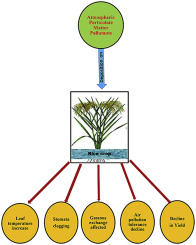当前位置:
X-MOL 学术
›
Atmos. Environ.
›
论文详情
Our official English website, www.x-mol.net, welcomes your
feedback! (Note: you will need to create a separate account there.)
Impact of particulate matter on basmati rice varieties grown in Indo-Gangetic Plains of India: Growth, biochemical, physiological and yield attributes
Atmospheric Environment ( IF 4.2 ) Pub Date : 2018-09-01 , DOI: 10.1016/j.atmosenv.2018.06.015 U. Mina , T.K. Chandrashekara , S. Naresh Kumar , M.C. Meena , S. Yadav , S. Tiwari , Deepak Singh , Pranav Kumar , Ram Kumar
Atmospheric Environment ( IF 4.2 ) Pub Date : 2018-09-01 , DOI: 10.1016/j.atmosenv.2018.06.015 U. Mina , T.K. Chandrashekara , S. Naresh Kumar , M.C. Meena , S. Yadav , S. Tiwari , Deepak Singh , Pranav Kumar , Ram Kumar

|
Abstract The study presents the first experimental evidence of the effects of atmospheric particulate matter (PM) deposition on two basmati (scented) rice varieties [Pusa Basmati-1509 (PB-1509) and Pusa Sugandh-5 (PS-5)] grown in Indo-Gangetic Plains (IGP) of India. Atmospheric PM load at the experimental site during rice crop growth period (August–November) was in the range of 162–660 μgm−3. The rice varieties growth, biochemical, physiological and yield attributes were monitored under three levels of PM deposition namely - low levels of PM deposition (LPM), ambient levels of PM deposition (APM) and elevated levels of PM deposition (EPM). PM deposition and PM flux on the canopy of rice varieties were 400–574 μgcm−2 and 24–58 μgcm−2day−1, respectively. PM deposition was 4.5% higher on the PS-5 than PB-1509 and among growth stages; it was the highest during the reproductive growth stage. Significant reduction in chlorophyll, leaf water and carotenoid content were observed in both varieties under EPM compared to APM. The air pollution tolerance index (APTI) also declined significantly. PM deposition enhanced leaf temperature (1–6%) of rice varieties under EPM compared to APM. The reduction in photosynthesis, stomatal conductance and transpiration of rice varieties under EPM were in the range of 9–52%; 6–40% and 8–46%, respectively compared to APM. PM deposition effects on plant height, the number of tillers and recoverable root biomass were found non-significant. PS-5 and PB-1509 exhibited 4–7% enhancement and 7.5–14% reduction in grain yield under LPM and EPM compared to APM, respectively. The results of the study indicate that increasing atmospheric PM pollution in IGP may adversely affect productivity and economic gains from scented basmati varieties of rice.
中文翻译:

颗粒物对印度恒河平原种植的巴斯马蒂水稻品种的影响:生长、生化、生理和产量属性
摘要 本研究首次提供了大气颗粒物 (PM) 沉积对两种印度香米(香型)水稻品种 [Pusa Basmati-1509 (PB-1509) 和 Pusa Sugandh-5 (PS-5)] 影响的实验证据。印度恒河平原 (IGP)。水稻作物生长期(8-11 月)试验点大气 PM 负荷在 162-660 μgm-3 范围内。水稻品种的生长、生化、生理和产量属性在三个 PM 沉积水平下进行监测,即低 PM 沉积水平 (LPM)、环境水平 PM 沉积 (APM) 和高水平 PM 沉积 (EPM)。水稻品种冠层的 PM 沉积和 PM 通量分别为 400-574 μgcm-2 和 24-58 μgcm-2day-1。PS-5 上的 PM 沉积比 PB-1509 高 4.5%,并且在生长阶段;它在生殖生长阶段最高。与 APM 相比,在 EPM 下,两个品种的叶绿素、叶水和类胡萝卜素含量均显着降低。空气污染耐受指数(APTI)也显着下降。与 APM 相比,PM 沉积在 EPM 下提高了水稻品种的叶温(1-6%)。EPM下水稻品种的光合作用、气孔导度和蒸腾作用减少9-52%;与 APM 相比,分别为 6–40% 和 8–46%。PM 沉积对株高、分蘖数和可恢复根生物量的影响不显着。与 APM 相比,在 LPM 和 EPM 下,PS-5 和 PB-1509 分别表现出 4-7% 的提高和 7.5-14% 的谷物产量降低。
更新日期:2018-09-01
中文翻译:

颗粒物对印度恒河平原种植的巴斯马蒂水稻品种的影响:生长、生化、生理和产量属性
摘要 本研究首次提供了大气颗粒物 (PM) 沉积对两种印度香米(香型)水稻品种 [Pusa Basmati-1509 (PB-1509) 和 Pusa Sugandh-5 (PS-5)] 影响的实验证据。印度恒河平原 (IGP)。水稻作物生长期(8-11 月)试验点大气 PM 负荷在 162-660 μgm-3 范围内。水稻品种的生长、生化、生理和产量属性在三个 PM 沉积水平下进行监测,即低 PM 沉积水平 (LPM)、环境水平 PM 沉积 (APM) 和高水平 PM 沉积 (EPM)。水稻品种冠层的 PM 沉积和 PM 通量分别为 400-574 μgcm-2 和 24-58 μgcm-2day-1。PS-5 上的 PM 沉积比 PB-1509 高 4.5%,并且在生长阶段;它在生殖生长阶段最高。与 APM 相比,在 EPM 下,两个品种的叶绿素、叶水和类胡萝卜素含量均显着降低。空气污染耐受指数(APTI)也显着下降。与 APM 相比,PM 沉积在 EPM 下提高了水稻品种的叶温(1-6%)。EPM下水稻品种的光合作用、气孔导度和蒸腾作用减少9-52%;与 APM 相比,分别为 6–40% 和 8–46%。PM 沉积对株高、分蘖数和可恢复根生物量的影响不显着。与 APM 相比,在 LPM 和 EPM 下,PS-5 和 PB-1509 分别表现出 4-7% 的提高和 7.5-14% 的谷物产量降低。









































 京公网安备 11010802027423号
京公网安备 11010802027423号